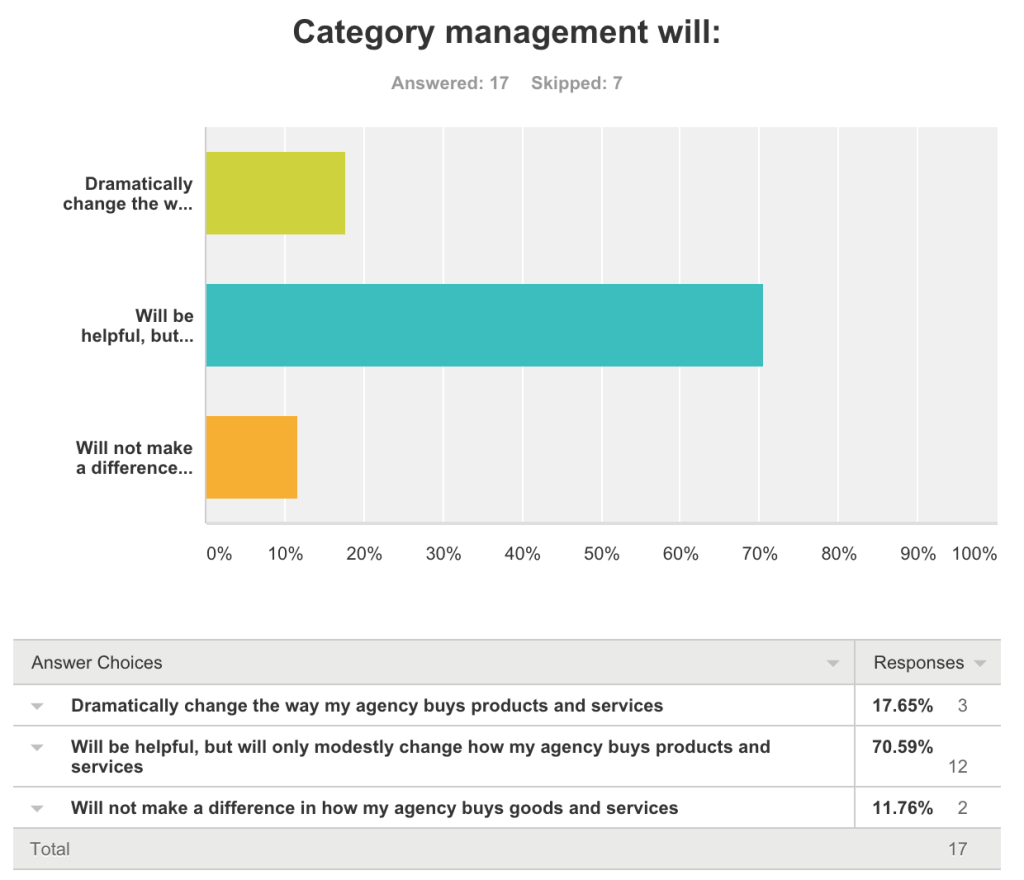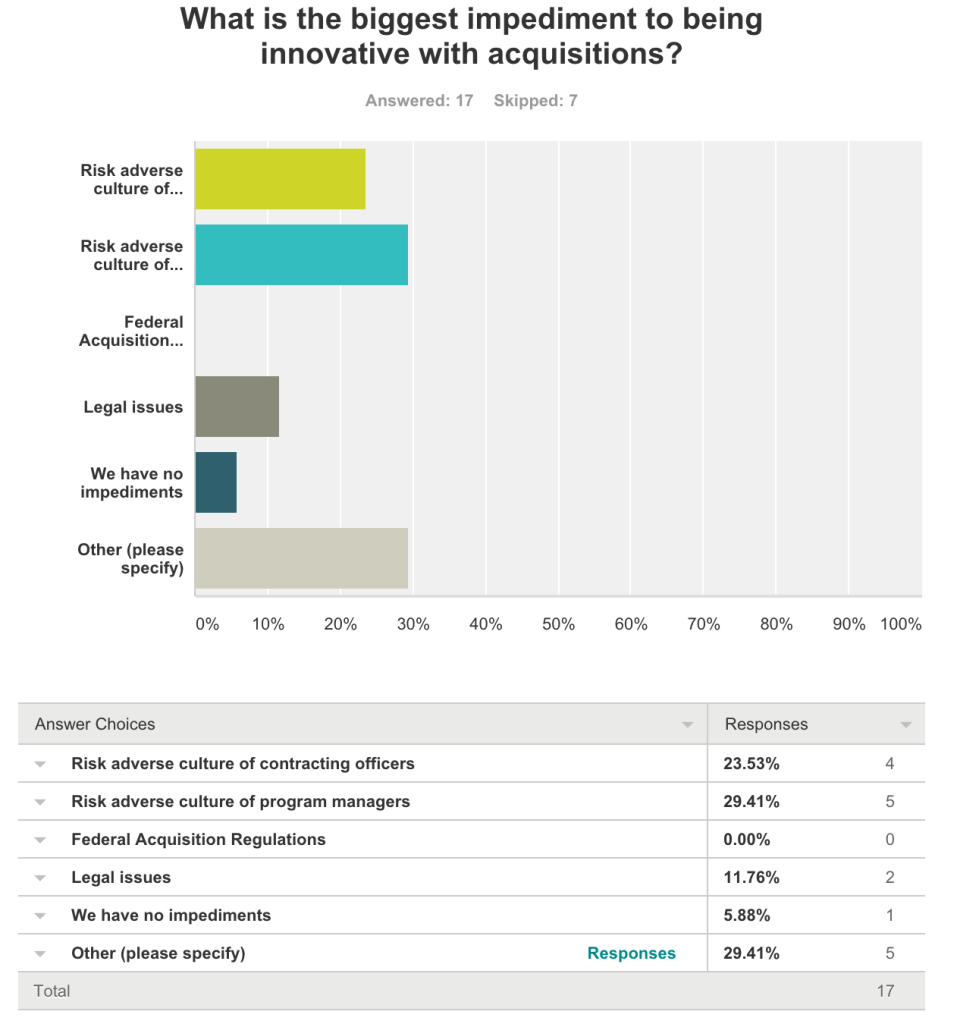
Exclusive
CAOs feel the pressure to get more bang for the buck
Federal News Radio’s fourth annual survey of chief acquisition officers and senior procurement executives found training, recruitment and retaining acquisition...
Federal chief acquisition officers continue to feel the pressure to hire, train and retain acquisition workers. But an old priority is gaining new life among CAOs and senior procurement executives (SPEs).
Federal News Radio’s exclusive 2015 CAO survey found these managers, more and more, want to find efficiencies in how and what they buy in order to deal with ongoing budget challenges.
Respondents to the survey ranked finding efficiencies slightly lower than workforce priorities. But, when compared to what CAOs and SPEs said in 2014, the push for spending money smarter and getting more bang for the buck was dramatically different.
In 2015, CAOs rated finding efficiencies less than one point behind hiring and retaining acquisition workers, while in 2014 they ranked it almost two full points behind workforce priorities.
“The combination of decreasing federal spending and increased demands for services creates a grave challenge,” wrote one respondent about the state of acquisition in government. “We need to fundamentally reimagine how we deliver services to the American people: hyper-intense oversight, intolerance of any failure, and the gotcha journalism of a 24-hour news cycle make that even more difficult.”
Federal News Radio conducted its fourth annual online survey of 120 CAOs and SPEs and received a 20 percent response rate. Of those who responded, 33 percent came from cabinet agencies and 17 percent from large agencies. 50 percent were CAOs or deputy CAOs while the rest were senior-level acquisition managers.
The Office of Federal Procurement Policy is trying to address several of these issues, including the decreased spending and the increased demand for services.
OFPP and the General Services Administration are launching the category management and prices paid data initiatives as a way to help them find those spending efficiencies.
But the survey showed CAOs and SPEs aren’t quite yet sold on this effort.
While a strong majority of the respondents say they understand the real and potential benefits of category management, almost 71 percent say it will be helpful, but will only modestly change how their agency buys products and services.

“[It] could dramatically drive changes, but we have a long ways to go. The federal government has spent many years as a separate and distinct buyer of the same products. This has led to many vendors and varied pricing. This will be a culture shift,” wrote one respondent. Another respondent said, there is “lots more to learn before widespread implementation” of category management.
While the governmentwide effort may be still in the nascent stages, similar programs at the agency level are finding a lot more success.
Take the Commerce Department as one example.
Barry Berkowitz, the senior procurement executive at Commerce, said his office conducted a spending analysis four years ago and identified several targets to apply the concept of strategic sourcing and category management in order to save money.
“We’ve returned no less than a 700 percent rate of return and as high as 900 percent on these efforts,” he said in an interview with Federal News Radio. “One example that we get a lot of notoriety for is our PC contract. We went from over 200 individual contracts to buy PCs and thousands of transactions requiring a contracting officer or specialist, down to one contract and no contracting officers or specialists required because purchases are done through a portal. We also do a constant technology refresh on the contract at least two times a year. We’ve been able to standardize configurations from multiple different configurations that anybody could pick out to three standard desktop configurations and three laptop configurations.”
Berkowitz said while the straight-forward cost savings are nice, the real impact has been on the reductions generated in administrative costs.
“Think about the fact that we go from thousands of contracting officers and specialists’ transactions to zero. That is a significant administrative savings,” he said. “That effort is one we are trying to replicate throughout our strategic sourcing efforts.”
Commerce’s analysis showed more than $800 million in common products and services that could be consolidated and better managed.
“Our intent is to build a single portal for all of the requirements coming through that. The data we are able to generate through the PC portal or through any of our other contracts is tremendous,” Berkowitz said. “That’s what you need to make sure you are not getting leakage and to find where you have issues, so we can adjust this and keep the efficiencies going.”
Berkowitz said the technology and data behind the portal would help the bureaus find the product or service they want to buy, know what approvals are necessary for that particular office or person, and receive as much or as little acquisition support as needed for the specific procurement.
Berkowitz said Commerce is looking further into its technology spending, as well as its human resources and contract close-out services, to determine what could be centralized across the department.
“It’s been almost a year since we started this process,” he said. “We just completed the current state and what the future state would look like, and defined the four areas we want to go after. The deputy secretary is the lead for this and our department management council is the governance board for this. We are now in the process of building our implementation plans. We don’t have those finished yet. I have, in my own mind, a view that it should take no more—and I’m sorry I’m going to say this—it shouldn’t take us any more than 18 months to have, at least, the first piece up and running. If we can do it faster, we will do it faster.”
While Commerce focuses internally, GSA and OFPP continue to stand up hallways under the Common Acquisition Platform (CAP) where much of this data will live.
More than half of the survey respondents said they have not used the hallways or other tools under category management yet. But several CAOs and SPEs said they are hopeful the new information will make a difference.
“I would like to see real value added to the hallways. Get the prices paid fully populated and continue to build out FSSI and other approaches to speed procurement,” said another respondent.
But others aren’t so optimistic.
“GSA and OFPP do not fully understand category management, at this time. Thus, those who are slated to use this concept do not fully understand it. The price portal will prove to be a ton of useless data,” said another respondent.
The tools in the hallways, such as sample contracts or market research data, are much needed by the acquisition workforce, CAOs and SPEs said.
The survey found that requirements definitions, project management and business acumen are among the top three skills needed by acquisition workers.
At Commerce, Berkowitz said, he’s trying to address the dearth of project or program management expertise.
“We have really spent a lot of time in trying to get and using the Federal Acquisition Certification for Program and Project Managers (FAC-P/PM) certification process in getting our people certified and identified, and getting the data associated with our data system so we can track and see where they are and really try to get them moving forward to the right level of education and skills, which comes from experience,” he said. “We have somebody almost dedicated to working with program managers to help them identify where they are and what they need to get to the right level for the different programs.”
Berkowitz also tracks and ensures the programs have the right level of program managers working on them. He said the Integrated Project Team (IPT) reviews the personnel and if the bureau has assigned someone who doesn’t have the right expertise, they are told to go back and train or find the right skill sets.
The missing capabilities around business acumen and requirements definitions also leads to struggles with innovation.
Only 53 percent of all respondents rated their agency’s ability to be innovative as fair, while those that rated their innovation capabilities as excellent or poor were equal at 24 percent.
The biggest reasons why innovation doesn’t happen is the risk averse culture of contracting officers first and program managers second.

“Program Management officials are largely not engaged, and do not take an interest in their acquisitions to the degree necessary for innovation,” commented one respondent.
Another said, along with risk aversion, legal and regulatory issues also stem the innovation wave.
Berkowitz said over his 35-plus year career in acquisition, innovation happens when you have flexibility in your processes. He said innovation comes out through several different paths.
Commerce’s acquisition council meets every two weeks. Off-site meetings with procurement officials and the sharing of best practices and discussions about risk-taking are also part of the way Berkowitz encourages innovation.
“We have a very strong enterprise risk management program in the department. It filters down all the way to the project level,” he said. “We have a very strong risk assessment that is done for each of the projects. Through that process, you can identify what the risks are, what the mitigation strategies are and what the benefits are.”
Overall, respondents have mixed feelings about the state of acquisition in government.
Some say there are real improvements, but there’s still a long way to go, while others are less positive.
“We need to continue to focus the upcoming workforce on soft skills and critical thinking. The FAR allows for flexibility, and risk-averse or conservative behavior is ineffective and inefficient,” said one respondent.
Another said, “Scarcity will put significant pressure on agency acquisition programs to show their value, ensure clear and direct support to the mission, and get on top of performance and cost management.”
A third senior manager said the future is bleak unless the workforce training is addressed.
“The state of procurement is bad. The bar has been set far too low by OFPP for training, education and certification. We must raise the bar for entry and continuation in this career field, or we’ll continue to waste scarce resources. The program management career field is in shambles outside of DoD, NASA and DoE [Department of Energy]. We must become as professional in our career fields as Certified Public Accountants attain. Raise the bar high and eliminate those who can’t cut the mustard.”
Copyright © 2025 Federal News Network. All rights reserved. This website is not intended for users located within the European Economic Area.
Jason Miller is executive editor of Federal News Network and directs news coverage on the people, policy and programs of the federal government.
Follow @jmillerWFED
Related Stories
2015 CHCO Survey: Despite declining budgets, CHCOs still desire outside training opportunities




